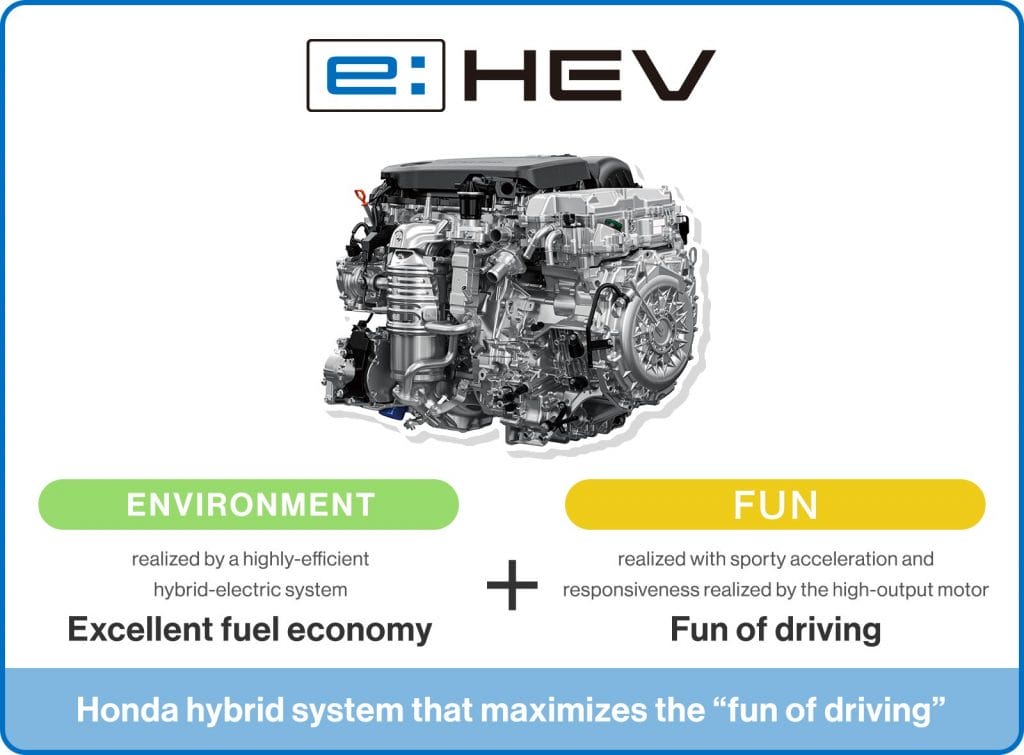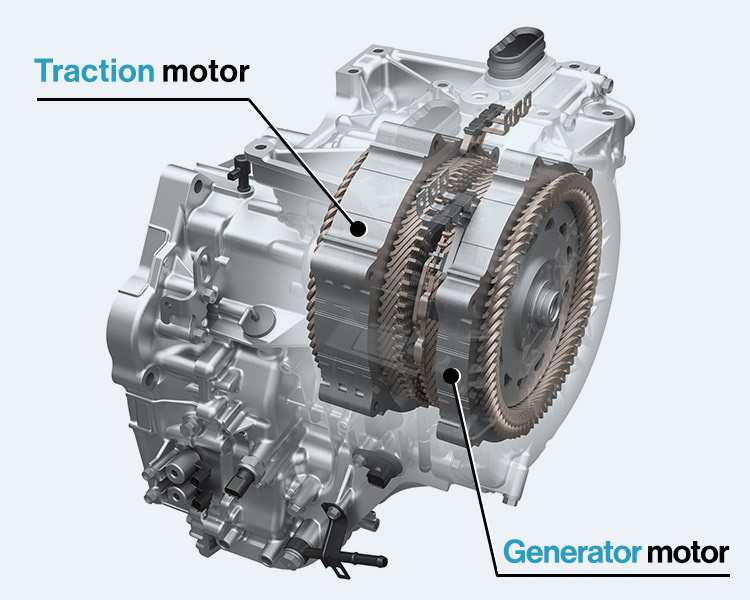Honda began taking initiatives, ahead of the times, to adopt electrification technologies to its automobiles in various ways, in order to reduce CO2 emissions, which Honda considers a critical challenge for a manufacturer of mobility products. Among these electrification technologies, hybrid-electric systems are the most familiar one, and Honda is further expanding its lineup of hybrid-electric models.
A hybrid-electric vehicle is equipped with electric motors in addition to an engine and achieves excellent fuel economy by efficiently using those two power sources.
The e:HEV hybrid-electric system was created by combining all of the engine and electrification technologies Honda has amassed to date and adopting a host of new technologies to achieve overwhelmingly high fuel economy and a new level of fun of driving.
The electric motor drives the vehicle for the entire speed range, and the internal combustion engine (ICE) is engaged only while cruising at high speed. This system achieves high environmental performance while offering the fun of driving unique only to e:HEV, unattainable with an ICE-only system.

Honda e:HEV Hybrid-electric System Brings the Best Out of the Motors and Engine
An ICE can generate high output at high-rpm range, but have difficulty in generating large torque at low-speed range such as when the car starts moving from a stop. Due to this characteristic, the fuel economy of ICE vehicles is not very high in urban areas frequent stops and starts are required. On the other hand, an electric motor can generate maximum torque from the low-speed range such as when the vehicle starts moving. By using an electric motor at low speed and an ICE at high speed, the hybrid-electric vehicle achieves high efficiency and thus high fuel economy.
Automakers around the world use different hybrid-electric systems, and all automakers use different systems depending on the size of the vehicle.
In general, there are three types of hybrid systems: 1) a series hybrid, in which the engine generates electricity and the electric motor drives the vehicle; 2) a parallel hybrid, in which the engine primarily drives the vehicle while the motor assists; and 3) a series-parallel hybrid, in which both the engine and motor act together to drive the vehicle.
For the low- to mid-speed range, where the motor has an advantage over the engine, the e:HEV works like a series hybrid, and drives the vehicle with a motor. During high-speed cruising, where the engine has an advantage over the motor, the e:HEV works like a parallel hybrid and the engine which is simply and directly connected to the tires primarily drives the vehicle. In other words, the e:HEV is an intelligent hybrid system unique to Honda, taking advantage of both series and parallel hybrid systems.

Difference with a series-parallel hybrid system
While the series-parallel hybrid system adjusts the ratio of engine and motor drive according to driving conditions, the e:HEV uses efficient motor drive for most daily driving situations. There are two modes of motor drive: EV drive mode and Hybrid drive mode. The e:HEV realizes high-quality motor driving and excellent efficiency for both modes by featuring a simple structure without a complex power distribution mechanism.
① Traction motor, Generator motor
The Honda two-motor hybrid system consists of a traction motor and a generator motor, which efficiently convert engine output into electricity, supply power to drive the tires and charge the battery, while also regenerating electricity during deceleration. The traction motor uses a magnet which is free of heavy rare earth elements.
② Atkinson cycle DOHC engine
This engine realizes a high-output Atkinson cycle with excellent thermal efficiency.
③ Lock-up clutch
During high-speed cruising, the system shifts into “engine drive mode,” where the engine output shaft is directly connected to the wheels. With gear ratios suitable for high-speed driving, equivalent to the top gear in a manual transmission, the simple power transmission path maximizes the highly efficient operation of the Atkinson cycle.
④ Power Control Unit (PCU)
The PCU consists of a power drive unit (PDU) that converts battery current to AC and a voltage control unit (VCU) that boosts the voltage to a maximum of 650V, based on the requirement by the traction motor. As a result of downsizing and an increase in efficient operation, the PCU fits inside the engine compartment.
⑤ Intelligent Power Unit (IPU)
The IPU is a power unit that combines lithium-ion batteries with an ECU for control, which efficiently stores and outputs electricity, contributing greatly to fuel efficiency and driving performance.
High Efficiency Realized by the Simplicity of the System With Two Dedicated Motors – Traction and Power Generation
The two-motor hybrid-electric system is equipped with a traction motor and generator motor. The traction motor is directly connected to the driveshaft, and regenerates electricity during deceleration. The generator motor is directly connected to the engine. The key feature of this system is its simplicity, eliminating complicated mechanisms necessary to mix battery/engine power or the transmission system. This simplicity ensures highly efficient and smooth driving, taking advantage of unique characteristics of the motor drive without frictional loss due to complex mechanisms. When the engine is used to generate electricity, losses are also minimized by directly driving the generator motor.

e:HEV Maintains its High Efficiency in All Driving Situations by Intelligently Switching Between Three Modes





